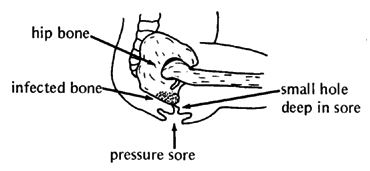CHAPTER 19
Bone Infections
Osteomyelitis
Bone infections are mostly a medical problem. Therefore we do not describe all of the many types of bone infections or details of medical and surgical treatment.
Chronic (long-lasting) bone infections are fairly common in villages where persons go barefoot and where injuries and illnesses that can lead to bone infections are frequent. They can be caused by fungus, or by many different kinds of bacteria (including typhoid, tuberculosis, and staphylococcus). Often these infections last for years, causing bone destruction and severe disability.
Bone infections are a very common complication of injuries, burns, and pressure sores in persons who have no feeling in their hands and feet. This includes persons with spina bifida (see Page 173), spinal cord injury (Page 196), and leprosy (Page 222). Because the person does not feel pain, often she does not rest, clean, or protect the injured area. As a result, it becomes infected. Gradually the infection gets deeper until it reaches the bone.
| THROUGH PROPER EARLY CARE OF SORES AND INJURIES, BONE INFECTIONS CAN USUALLY BE PREVENTED. |
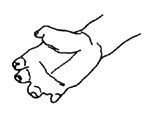
The loss of parts of the body sometimes seen in a person who has leprosy (Hansen's disease) is not caused by the leprosy germs. It is caused by other germs, which infect the bone because of injuries the person gets that are not cared for because they do not hurt.
| WARNING: Deep pressure sores that
do not heal, even after they are kept clean and no weight or
pressure has been put on them for months, may have a bone
infection. Bone infection is especially likely if the sore
reaches the bone, or if a small hole at the bottom of the sore
refuses to close and drains liquid or pus. If you think
there might be a bone infection, get medical help if possible
and go through all the steps to treat it adequately.
|
Signs of chronic bone infection
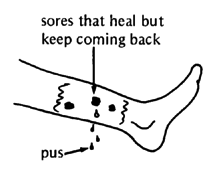
| The skin near a bone has small, deep sores that heal and then open again to drain pus. Gradually the affected area gets bigger and new holes open. | |
| There may or may not be pain. | |
| The pus may or may not smell bad. | |
| Usually there is no fever-except sometimes at first or at times when the infection gets into the blood. | |
| Often the infection will get better with antibiotics, but keeps coming back. | |
| The affected bone may gradually become thicker as it is destroyed inside and forms a new bony covering. |
Treatment
| Whenever possible get experienced medical help. | |
| If treated early with the right antibiotics in the right (high) dosage, sometimes the infection will go away and not come back. If possible, a sample of the pus should be studied (cultured) by a medical laboratory to find out what kind of infection it is and what rnedicine is likely to work best. Usually the medicine should be taken for a long time (months). | |
| If you cannot get the pus cultured, you might try treating the infection with tetracycline (by mouth), or dicloxicillin (a special penicillin). Use relatively high doses. For dosage and precautions, see Where There Is No Doctor or a medical text. | |
| Surgery may be needed to remove the dead, infected bone. | |
| Sometimes amputation is necessary (see Page 227). | |
| Even with excellent treatment, after months or years without problems, new sores may open and again begin to drain from the infected bone. |
Rehabilitation and aids
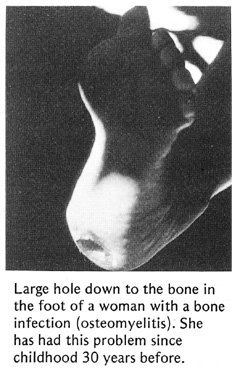
What kind of rehabilitation or orthopedic aids may be needed will depend on the amount of destruction that has occurred. Sometimes surgery cannot be obtained or the person may prefer to live with the problem rather than with an amputated limb.
For prevention, rehabilitation, and aids, see Chapters 24, 26, and 58 on pressure sores, leprosy, and braces.
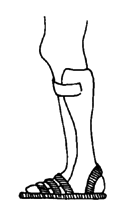
When there has been a lot of bone destruction, sometimes a brace can help make walking easier.
| WARNING: The pus coming from the infected bone may cause serious infections in other persons. Change bandages regularly; boil them before using them again, or burn them. Wash hands often. Take great care with hygiene. |

